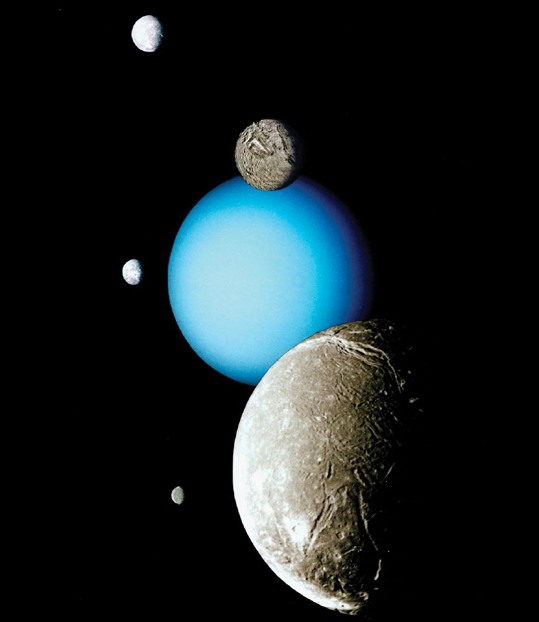1986
Voyager 2 at Uranus
During its flyby of Saturn in 1981, NASA spacecraft engineers used the gravity of the ringed planet to steer the Voyager 2 space probe onward to an encounter with the giant planet Uranus in January 1986. This was the third stop in Voyager 2’s Grand Tour of the outer solar system, and remains the only spacecraft encounter with Uranus and its bluish atmosphere, icy rings, and moons.
Discovered in 1781 by English astronomer William Herschel, Uranus is tilted on its side—the planet rolls rather than spins around the Sun. Voyager 2 mission planners had to guide the spacecraft to within about 50,000 miles (81,000 kilometers) of the upper cloud layers of Uranus to gain the precise gravity assist needed to propel the spacecraft on to Neptune. The trajectory allowed a close flyby of the small inner moon Miranda, and more distant views of the geology of the four other large moons—Ariel, Umbriel, Titania, and Oberon.
The encounter was incredibly successful and yielded many new and enigmatic discoveries about the Uranian system. Planetary scientists discovered that Uranus has a strong magnetic field, comparable to Saturn’s but weaker than Jupiter’s, and strangely tilted relative to the planet’s sideways spin axis. Eleven small new moons were discovered in the imaging data, and detailed images were obtained of the nine dark rings that had been previously discovered from Earth-based telescopic measurements. Voyager 2 data revealed that the aquamarine color of the Uranian cloud tops is caused by small amounts of methane, and analysis of density and other data indicated that beneath the hydrogen- and helium-dominated atmosphere, the planet has an icy mantle and an Earth-size rocky, metallic core. A lasting legacy of the Voyager 2 encounters is the discovery that both Uranus and Neptune are ice giants, not gas giants.
For many, though, the highlight of the encounter was the spacecraft’s close pass by the tiny moon Miranda, only 300 miles (480 kilometers) wide. The images revealed a patchwork-quilt pattern of giant fractures, ridges, and cliffs interspersed with bland, cratered, icy terrain—a landscape like no other seen before or since in our solar system. Miranda appears to have been ripped apart and then reassembled out of order, perhaps in the same giant impact event that may have toppled Uranus over.
SEE ALSO Uranus (c. 4.5 Billion BCE), Neptune (c. 4.5 Billion BCE), Discovery of Uranus (1781), Titania amd Oberon (1787), Ariel and Umbriel (1851), Miranda (1948), Uranian Rings Discovered (1977), Pioneer 11 at Saturn (1979), Voyager Saturn Encounters (1980, 1981).
Montage of Voyager 2 images of the ice-giant planet Uranus from January 1986—our first and only encounter with the seventh planet. Counterclockwise from the foreground: the icy moons Ariel, Miranda, Titania, Oberon, and Umbriel.
